After Galapagos, we spent a few days in Quito, Ecuador, which was unexpected. (Because we thought we’d be leaving Galapagos on a sailboat bound for French Polynesia – which we did not do.) Quito is a city of over 3 million people, and is at an elevation of about 9,000 feet, both of which came as a big surprise to us. 9,000 feet – even at the equator – can get pretty chilly! Fortunately for us, it was in the 60’s during both days we were there, because we had packed for French Polynesia – short pants and t-shirts! We enjoyed Quito, in large part because we spent the first of our two days there exploring it with Beth and Pat, who faithful readers will remember from the Galapagos post. But I’m not going to write any more about it. If you want to know more about Quito, GTS! (That’s what Fran’s sister Ingrid says to her teenagers when they ask her almost anything – “GTS! Google That Sh**!”.)
From Quito, we flew to Ft. Lauderdale, FL, spent a few hours in the airport, then flew to San Francisco, spent the better part of a day, then flew the 8+ hours to Pape’ete, Tahiti, French Polynesia, and from there, we took the half-hour ferry ride to the island of Mo’orea – which is the topic of this post. I’m going to try to make a post about each of the islands we visit in French Polynesia, and each of them will be fairly short, and not very funny – sorry. I’m trying to be more timely, and it comes at the expense of humor.
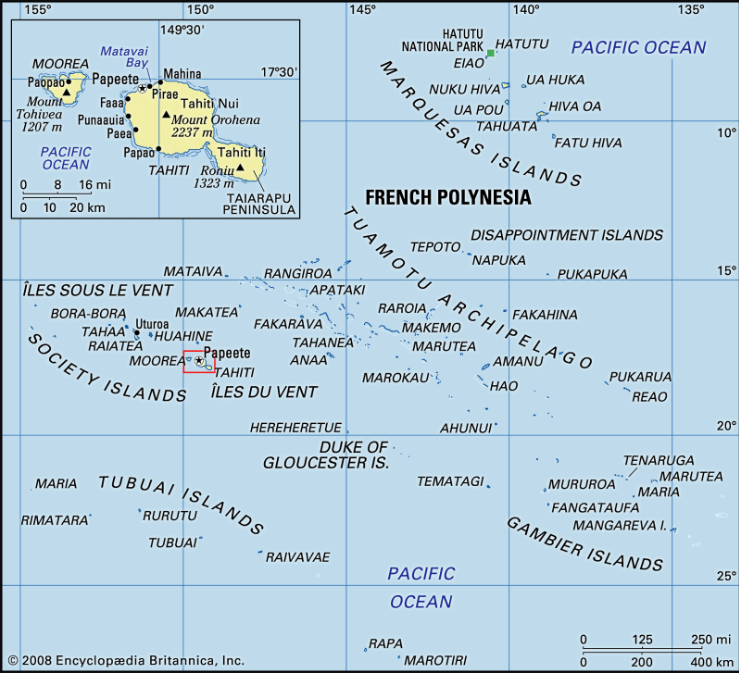
Before I dive into Mo’orea, let me give a brief geography lesson. I was totally ignorant of the geography of French Polynesia, and you may be, too, so here goes. French Polynesia is a country – sort of. It’s part of France – sort of. But it refers to a bunch of islands and atolls (121, officially) in five main groups: the Society Islands archipelago, comprising the Windward Islands and the Leeward Islands; the Tuamotu Archipelago; the Gambier Islands; the Marquesas Islands; and the Austral Islands. The Society Islands includes the most famous of the islands, Tahiti, which is home to the capital city, Pape’ete. It also includes the second most famous island, Bora Bora, and Mo’orea, the topic of this post. There is a group of islands between the Marquesas and the Tuamotus, called the Disappointment Islands. Not sure why they’re not listed anywhere – I’m sure that’s disappointing to the residents there. (What the Fakahina?!?!) During this trip, we will visit seven islands in three of the groups, and if I don’t run out of steam, you’ll get to learn a little about each of them over the course of the next few months. If you want to know a lot more about them, GTS!
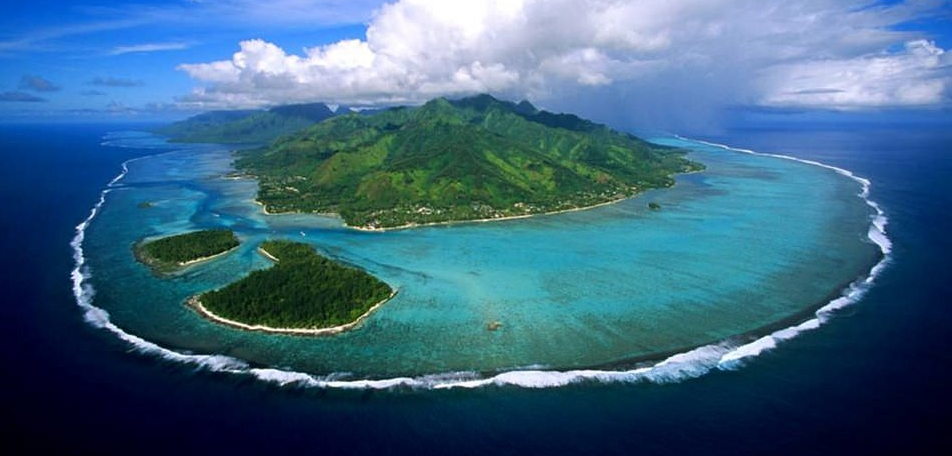
Mo’orea, like most (all?) of the islands and atolls of French Polynesia, is what’s left from a very old volcano. The peaks in the middle are dramatic – lots of sheer cliffs, mostly completely covered in green. When the sun is just right, or the clouds are covering just the tops of them, they are quite striking. The reef completely surrounds the island, and the only road of any significance runs the entire 61 kilometer (38 mile) circumference. You can’t get lost – everything is on this road, either “ocean side” or “mountain side”. We couldn’t rent a car (none were available for rent during our stay), so we rented a scooter, and drove the entire way around the island at least four times during our week there.
There isn’t a whole lot to do on Mo’orea. There are some touristy things to do, but not many, and we tend to shy away from those things anyway. You can get in the water at the three public beaches, but only two of them had water we could snorkel in – the third had such a current ripping across the beach that we could barely keep from being swept away. And there are some hikes you can do up those gorgeous green peaks. So we did a little of each.
First, the snorkeling. Almost immediately upon getting in the water, we started seeing fish we had never seen before, except in the fish ID books. The most immediately obvious were the butterfly fish, four species of which we’re familiar with in the Atlantic and Caribbean. Well, French Polynesia doesn’t have any of those four, but it has what seems like a newly created species of butterfly fish approximately every additional 10 minutes that we’re undewater here! They are absolutely everywhere, and absolutely beautiful! Most seem to be some combination of black, white, and yellow, but the combinations seem endless, as are the shapes and sizes. Some are kind enough to allow a decent photo now and then, but some are so shy that it may take the rest of our trip before we happen to snap even a good speciment shot. This happens frequently: see a fish you want to photograph, start moving towards that fish to set up the shot, and another equally or even more beautiful fish swims in front of you, distracting you from the first fish, and now you’re about out of breath so you can’t chase the second fish. Oh, well – we love seeing them, and chasing them, and are so happy when we do manage to fire off a good shot of one.
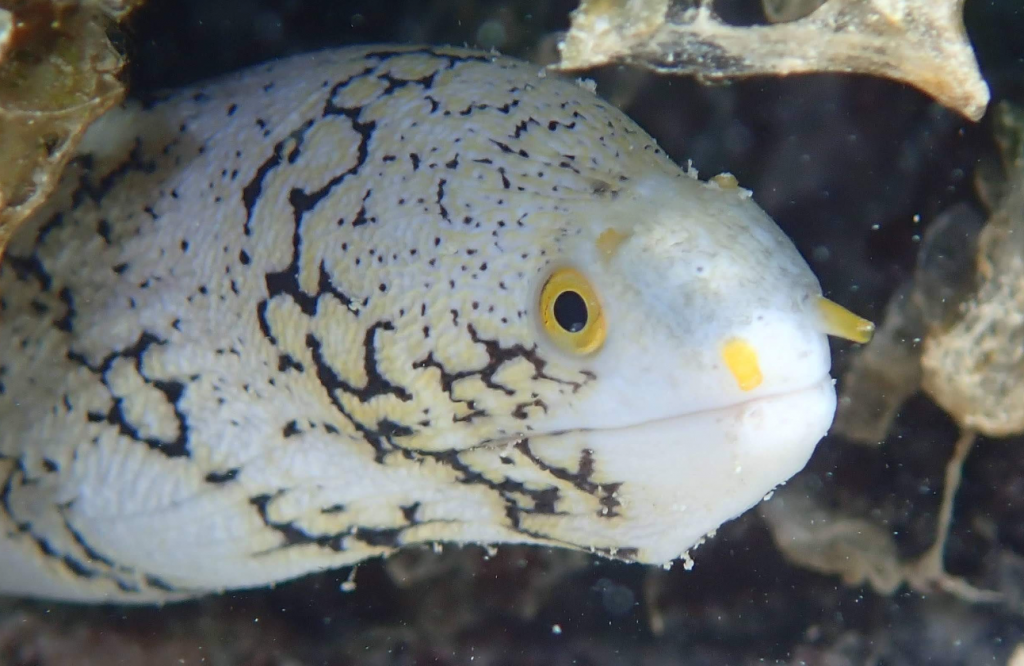
Most of the above can be said about the angel fish, the surgeon fish, the trigger fish, the unicorn fish, and several more groups of fish that we see all over: there are a lot of different ones, all are beautiful or strange or worthy of shooting for one reason or another, we’ve never seen them before, and they are challenging to shoot. I’ll include some of of our better shots from Mo’orea in this post, and will provide a link to all of our pix from there. Also, if you keep up with my posts about each island as we go (assuming I keep up!), you’ll see more and more pictures, and will start to recognize the usual suspects, because I know we won’t stop shooting them!
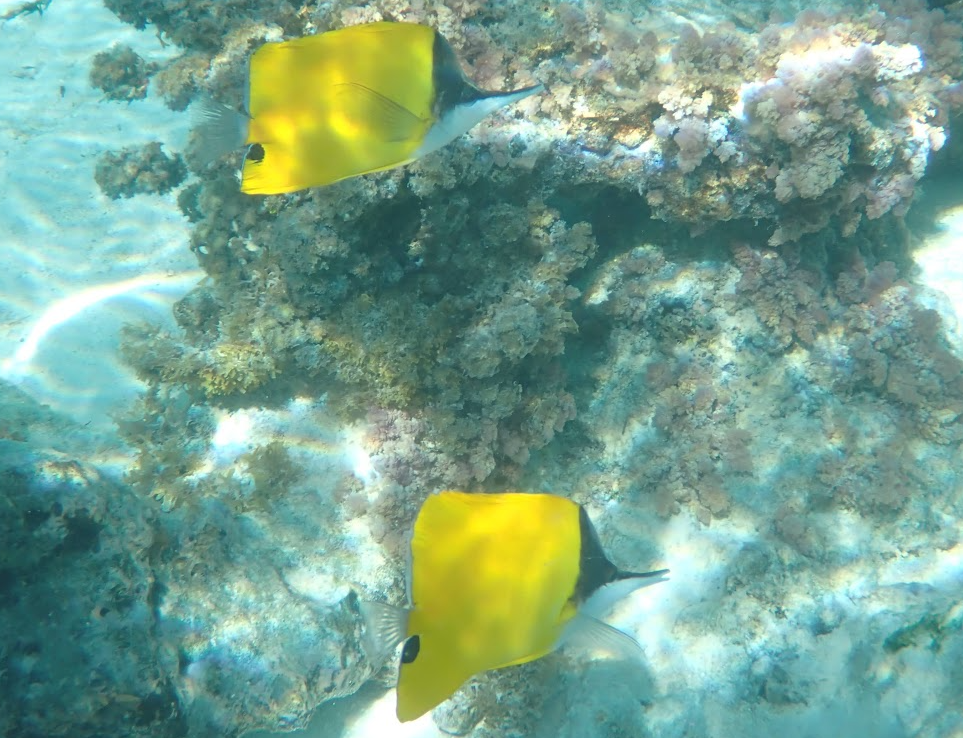
We did only one touristy thing: we took a boat tour of the two big bays on the north end of the island, with some dolphin watching, snorkeling, and lunch. The dolphins here are of two different species – at least the ones we’ve seen so far. On the boat tour, we had a couple small pods of what they call locally “spinner dolphins”, because when they jump out of the water while underway, they sometimes spin in the air. We’ve had spinners swim with us in the Caribbean, and they left no doubt that they were spinners with their aerial displays. The ones we saw here didn’t spin, but they were just swimming around in a bay, looking for lunch, so I wouldn’t have expected to see them spinning. Still, they didn’t look like the same species we saw in the Caribbean, so I guess I’ll have to GTS one day.
The snorkeling we did on the boat tour was in very shallow water, after the boat was parked so they could prepare lunch. There were some fish, but the main attraction was the sharks and rays. Everywhere you looked there were white tipped reef sharks in the 3 – 5 foot size range. We were in an area where lunch is often prepared for tourists, and the sharks get the scraps, so of course they hang out. It was not at all a shark feeding type of thing, however (we think those should be abolished – bad for the sharks, and occasionally very bad for divers) – the sharks are just hanging out, hoping for a scrap of fish now and then, which makes for some fun snorkeling. The rays are doing the same thing – very similar to the rays we have in the Atlantic and Caribbean, but a different species. (Reminds me of that old Steve Martin bit, which he concludes by saying “Those French have a different word for everything!” French Polynesia seems to have a different species of everything.)
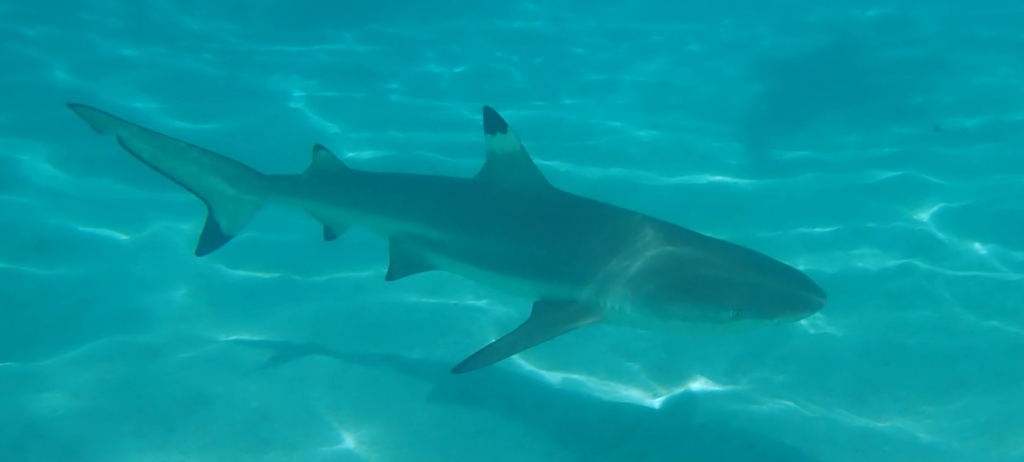
Finally, it was time for lunch. I didn’t expect lunch to be the highlight of the excursion, but it most certainly was! They set up the table and chairs in the water, about knee-depth. On the table they set bowls of tuna in coconut milk, tuna carpaccio, grilled chicken, grilled fish (not tuna), pasta salad, a cabbage salad similar to coleslaw, but not quite, and fresh pineapple, dragonfruit, and ripe papaya. All of it was delicious, as freshly made as it could be, and came with the added benefit of rays and little fish tickling our ankles and feet as we ate! (Side benefit of our excursion that day – we met Francesca and Luis, a couple from Puerto Rico now living and working in, of all places, Chattanooga, Tennessee! They were great – we had dinner with them a few nights later. They’re the couple on the left in the picture.)
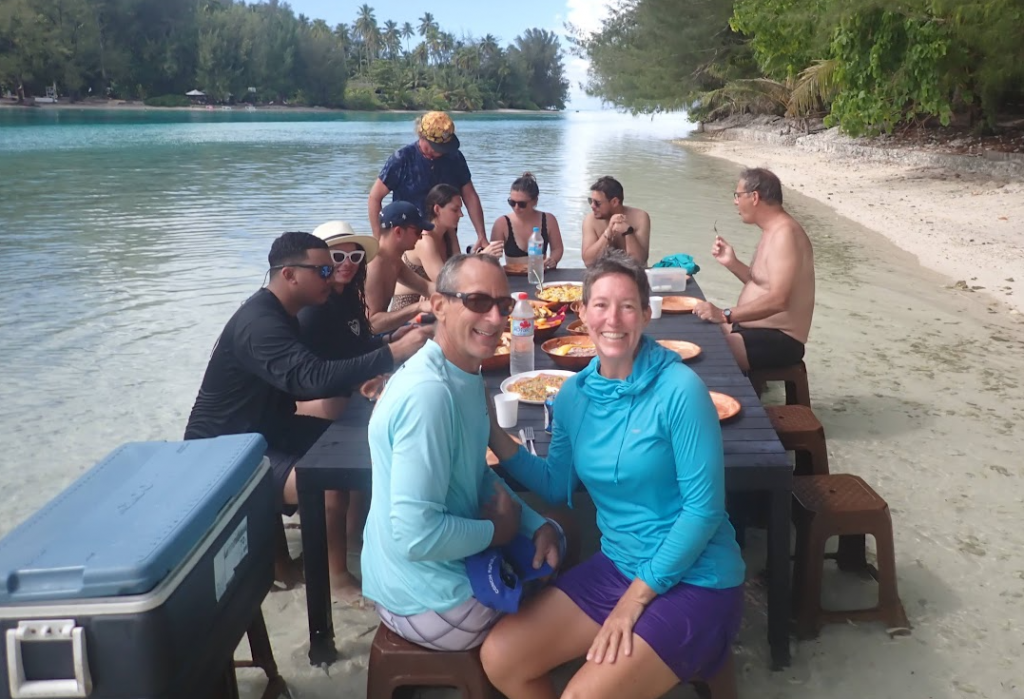
The last activity we did was a hike up one of the peaks. Not the tallest – that would involve some actual mountain climbing. But one in the middle that, from the top, supposedly has a panoramic view of most of the island. I say “supposedly” because, when we were no more than five minutes from the peak, we encountered a landslide that had occurred just the night before, the result of some crazy wind immediately following a really thorough drenching. We managed to clamber over the first fallen tree in our path, but after that, what was left in our path was a bit too precarious, and we didn’t want to become the most talked-about event on the island for the next week: “Stupid American Tourists Killed Trying to Traverse a Fresh Landslide on the Three Coconuts Peak.” Sub-headline: “What The Hell Were They Thinking?”
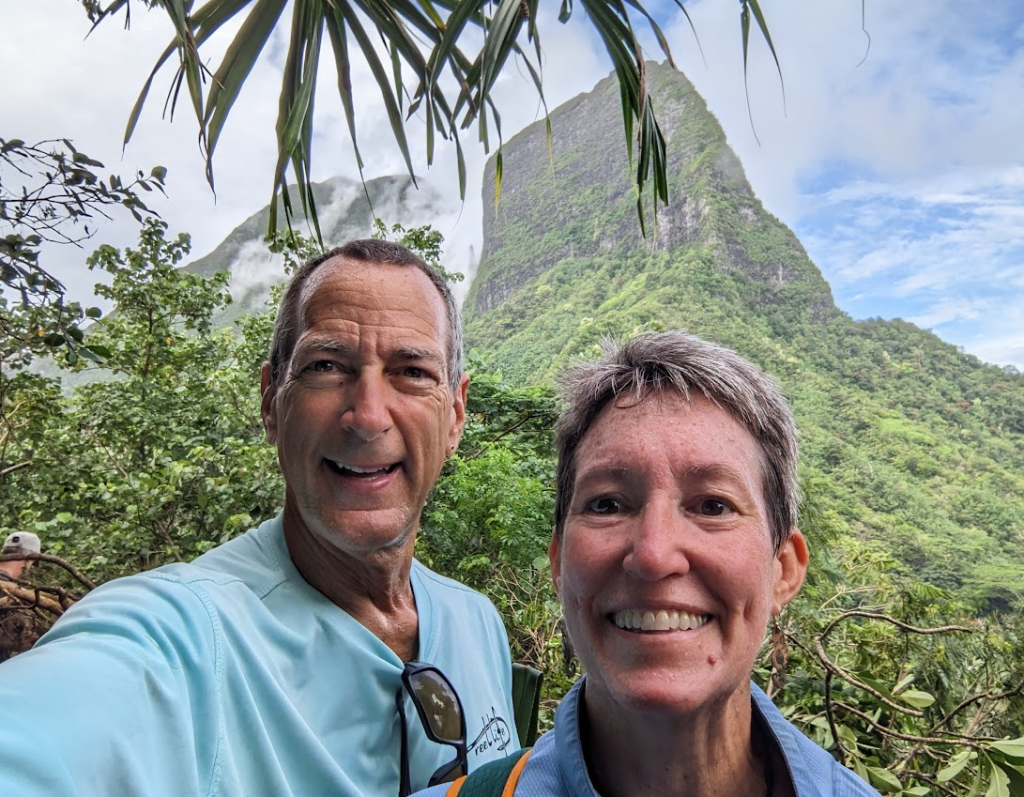
We chose not to scuba dive on Mo’orea, because it’s not known for it, and the next two islands (Rangiroa and Fakarava) are, so we decided to save our dive budget for later.
Lodging on Mo’orea was interesting. There are a few very nice places – one of them has the little bungalows over the water, which look fantastic, but they’re also $850 per night, so no, we didn’t stay there. But mostly, there are small, quite modest places mostly with the name “Fare Something-or-other”. Fare means “house” or “home” in Tahitian, but it implies “guest house”. We didn’t stay in one, though, so I don’t even know why I’m telling you that. We did stay in an airbnb that was listed as a “Private room in a home”. Shared bathroom, shared kitchen, shared everything except the bedroom. OK – we had to book on short notice, let’s give it a try. What we didn’t find out until we arrived was that we would also be sharing the mold and fungus in the bathroom, the dog hair from the five dogs, the clutter from the woman’s grandchildren, and the grease, dirt, and food waste in the kitchen. Needless to say, we spent just one night there.
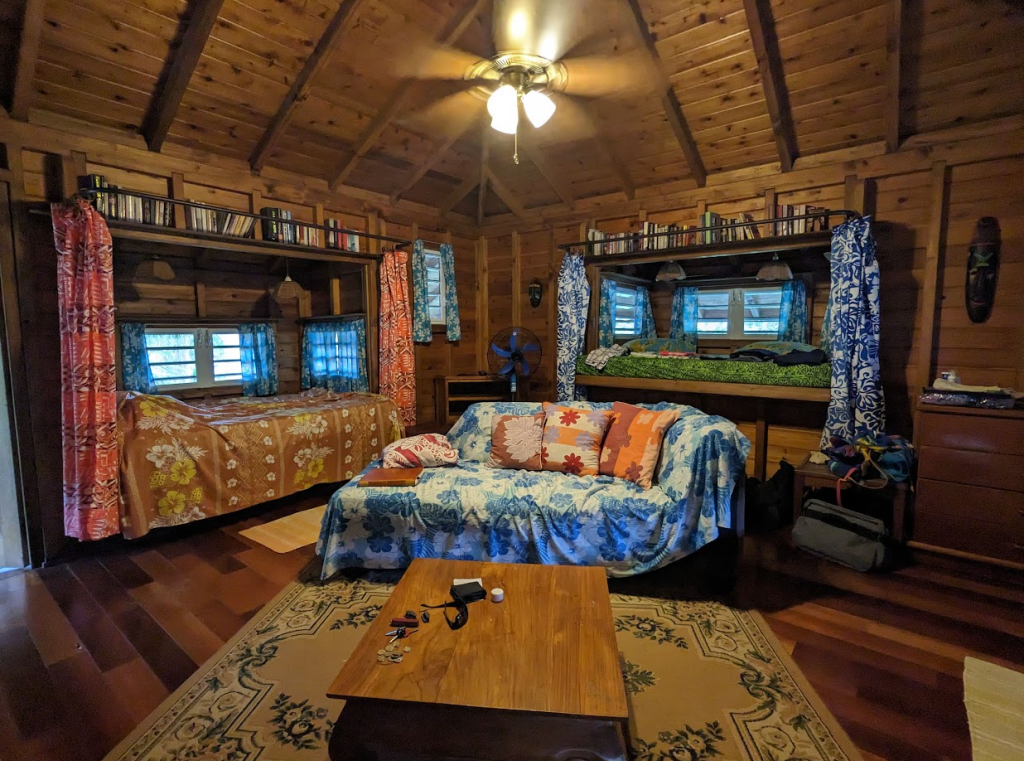
Fortunately, we then found Mark’s Place! Mark is an American who moved to French Polynesia in 1981 when he was 28 (he’s now 70), and to Mo’orea in 2000. He bought a piece of property with nothing on it, and started building things. (He’s a carpenter / furniture maker by trade.) First, a workshop, then a very tiny place for him to live. He just keeps building things, and now has five or six bungalows of varying sizes, and one of them, big enough to sleep eight, became available unexpectedly, so when we called about needing a place right now, they said sure, come on over, and we’ll charge you only the rate for our smallest bungalow. So we had the beautiful two story bungalow that sleeps eight upstairs, and downstairs has a full kitchen and dining room, and a bathroom with two sinks, two showers, and two toilets. And it came with two kittens! Not tiny kittens, but kittens in the 5 – 7 month range, who both loved to be petted, and one of whom would sit on a lap for the duration of our morning “long coffee” sessions. Boy, did we make a move up in the world when we came to Mark’s! And Mark is a super nice guy who is a much better talker than listener, but fortunately, he had a lot more interesting things to say than we did, so it worked out just fine.
Alright, that’s all I have for Mo’orea. So much for making a short, sweet post with some pictures. Better luck next time! (That’ll be Rangiroa.)
Here’s the link to our Google Photos library for Mo’orea – enjoy!
P.S. – Although we live in a place where coconuts are common (we have 13 coconut trees in our yard), it wasn’t until we visited Mo’orea that we started to learn all the really great ways to use the coconut and the fronds. You can bet we’ll be stepping up our coconut game when we get back to Southermost Smartini!
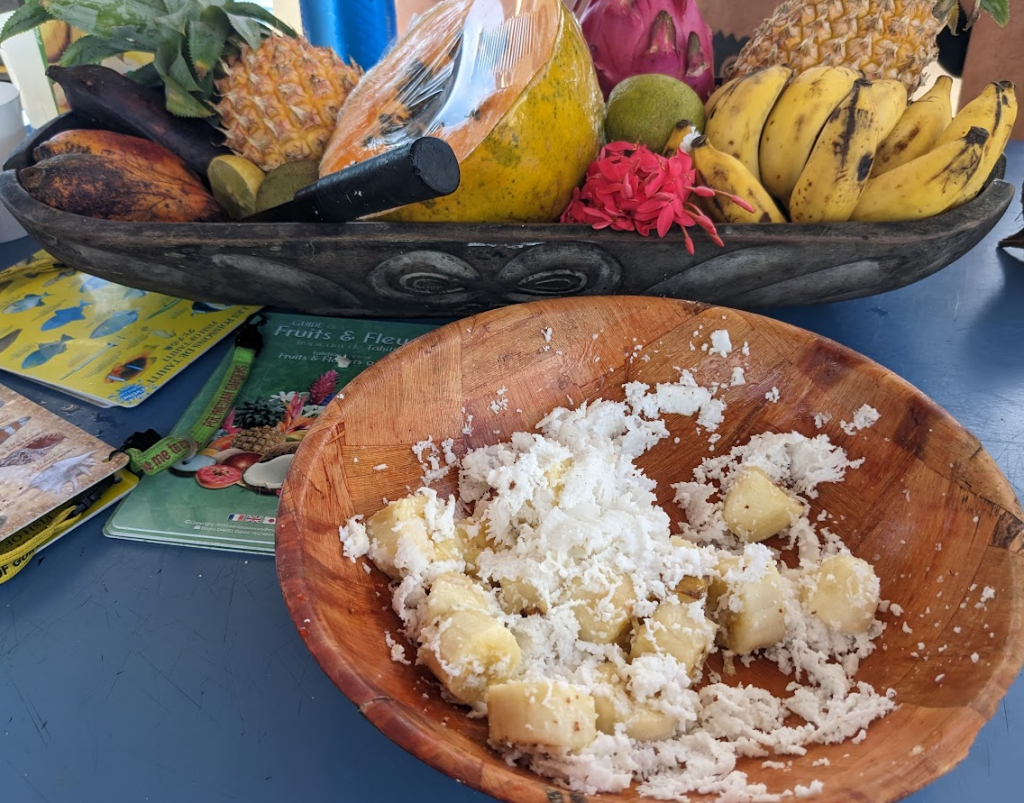
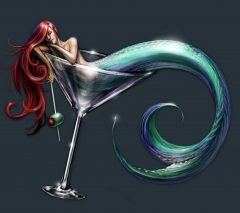
Another great post. Keep them coming. Some good humor even for a “humorless“ posting.
Well, I had to squeeze in a chuckle or two!
Glad you got out of Ecuador, there’s still real head shrinkers there.
And how, exactly, do you know this, Tad?
Enjoyed the post, Brian!
Mo’orea! I just met the island Mo’orea!